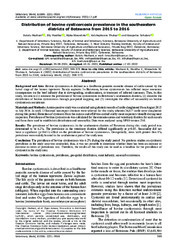| dc.contributor.author | Mazhani, Batatu | |
| dc.contributor.author | Masitha, Elly | |
| dc.contributor.author | Ntwaetsile, Mpho | |
| dc.contributor.author | Thutwa, Ketshephaone | |
| dc.contributor.author | Sehularo, Kerapetse | |
| dc.date.accessioned | 2022-06-03T12:45:49Z | |
| dc.date.available | 2022-06-03T12:45:49Z | |
| dc.date.issued | 2022-02-17 | |
| dc.identifier.citation | Batatu Mazhani, E. M., Ntwaetsile, M., Thutwa, K., & Sehularo, K. (2022). Distribution of bovine cysticercosis prevalence in the southeastern districts of Botswana from 2015 to 2016. Veterinary World, 15(2), 368. | en_US |
| dc.identifier.issn | 2231-0916 | |
| dc.identifier.uri | https://hdl.handle.net/13049/477 | |
| dc.description.abstract | Background and Aim: Bovine cysticercosis is defined as a foodborne parasitic zoonotic disease of cattle caused by the larval stage of the human tapeworm Taenia saginata. In Botswana, bovine cysticercosis has inflicted major economic consequences on the beef industry due to downgrading, condemnation, or treatment of infected carcasses. Thus, in this study, we aim to (1) estimate the prevalence of bovine cysticercosis in Botswana’s southeastern districts, (2) describe the distribution of bovine cysticercosis through geospatial mapping, and (3) investigate the effect of seasonality on bovine cysticercosis occurrence.
Materials and Methods: A retrospective study was conducted using abattoir records of cattle slaughtered from August 2015 to July 2016. In total, 13 licensed non-export abattoirs were selected for this study, wherein 26,827 cattle were slaughtered during this period. Detection of cysticerci from the carcass and offal was carried out by meat inspectors visually during meat inspection. Prevalence of bovine cysticercosis was calculated for the extension areas and veterinary districts for each month and form there used to establish its distribution and seasonality. Data were analyzed using SPSS version 25.0.
Results: The prevalence of bovine cysticercosis in the southeastern districts of Botswana during this study period was determined to be 6.2%. The prevalence in the veterinary districts differed significantly at p<0.05. Seasonality did not have a significant (p=0.651) effect on the prevalence of bovine cysticercosis. Geospatially, areas with greater than 8% prevalence were mainly located in the southernmost part of the study area.
Conclusion: The prevalence of bovine cysticercosis was 6.2% during the study period. No previous studies on cysticerci prevalence in the study area was conducted; thus, it was not possible to determine whether there has been an increase or decrease in terms of prevalence rate. Therefore, the results of this study can be used as a baseline for the prevalence of cysticerci in the study area. | en_US |
| dc.language.iso | en | en_US |
| dc.publisher | Veterinary World | en_US |
| dc.relation.ispartofseries | Veterinary World;15(2), 368. | |
| dc.subject | Bovine cysticercosis | en_US |
| dc.subject | Prevalence | en_US |
| dc.subject | Geospatial distribution | en_US |
| dc.subject | Meat industry | en_US |
| dc.subject | Seasonal occurrence | en_US |
| dc.title | Distribution of bovine cysticercosis prevalence in the southeastern districts of Botswana from 2015 to 2016 | en_US |
| dc.type | Article | en_US |

